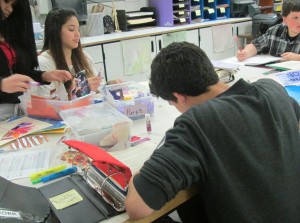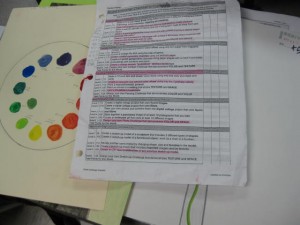I was asked in the TAB-Yahoo group to update them on how the challenge was going, specifically in regard to the points. One teacher questioned whether the kids would obsess about the points and get competitive in a negative way. So far that has been far from the case!
With this new studio challenge the goal was to earn 150 points in 3 weeks. I thought 50 points per week was reasonable. Point’s check-ins proved otherwise. Very few kids were progressing at that speed, while others were zipping along at high speed. So I did some mini lessons on applying boosts hoping that would help. I had the higher point’s kids share what they were doing to earn points. Then the state testing schedule came out and I realized how messed up my classes would be so I extended the unit for 2 more weeks. Today I did another check in, only to discover numerous kids still less than 50 points here after 3+ weeks.
Time for some chats! Talking to the low points kids privately I discovered some common issues.
~Absences: We have a lot of issues with this in our low income population. Along with that, the ones that have weekly absences don’t follow up with their teachers or classmates to see what they missed or how they can catch-up. Nor do they do homework to make up missing work. Often they don’t even recall what we were working on when they were last in class. In these chats, I tried to emphasize the need to catch up on drawing assignments at home so that they could use other centers during class.
~Indecision: A few students indicated that they started things, gave up, and then started something else without making progress or learning new skills. I discovered that my students are having issues with perseverance and the uncertainty of having more freedom. Perhaps some time management issues are involved too.

~Distraction: It is spring and given the opportunity to talk and draw, the kids end up talking more than drawing. So when I asked why they thought they were behind on points/projects, some kids just said “I don’t know.” When I probed, telling them what I noticed… That they did a lot of talking and not a lot of working… They would admit that maybe they were distracted. These kids are the same ones that got distracted and behind on my more teacher-directed lessons too, so it is not the fault of the Choice unit entirely. But I don’t want to restrict talking entirely since lots of collaboration and peer tutoring is happening throughout the classroom. Instead I am redirecting the same individuals over and over again.
~Ambivalence: A handful of kids (thankfully small) said they hadn’t done any work because there was nothing on the challenge list that they wanted to do. But when I asked “if you could do any project in the world, what would you do?” the answer was “I don’t know.” I tried to explain that right now they had more than 30 different projects to choose from, but if we went back to teacher-directed they would have only 2 or 3 choices. (Choices in Media, themed project is my usual modified choice.) Ultimately, from the discussions, I determined that a lack of choices isn’t the problem, but the teen ambivalence of making a choice and sticking to it.
So how do middle school teachers deal with absences, ambivalence, distractions and indecision? TAB-Choice is no magic bullet but giving kids more choices can often increase engagement and decrease behavior issues. So what to do when it doesn’t? If you figure that out, let me know! I’ll keep trying on my end, too.
Meanwhile, the self-motivated kids are moving along, making great experiments and projects, learning things and having FUN!
~~
How do you teach perseverance?
How do you deal with frequent absences?







